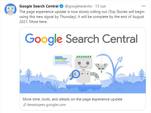
Google’s June/July 2021 Algorithm Update Unpacked
Written by Simon
On Wednesday 2 June, Google gave SEOs the customary few hours of notice that it was core algorithm update time once again; keyword ranking trackers were duly swamped and fingers were crossed firmly in the hope of positive outcomes for their sites.
As the search engine’s engineers commenced the rollout of Google’s June 2021 Core Algorithm, we learned this particular update had a twist in the tale. It was quickly confirmed that a July Core Algorithm update was to follow hot on its heels, sending global tremors throughout the world of natural search. The second part of the update duly arrived on Thursday 1 July and is expected to take up to two weeks to finish rolling out.
How Could a Two-Part Algorithm Update Affect My Rankings?
Although Google is well known for rolling out algorithm updates on a semi-regular basis — acknowledging some, keeping quiet about others — a main core update is always worth paying attention to. This is the first all-singing, all-dancing update that the search giant has confirmed since December 2020, an unforgettable Christmas gift for search marketers.
With the second algorithm update having begun rolling out in early July, we can’t really expect to see the full impact of this initial update until around the end of the month. There will be telltale signs of whether our sites are onto a winner or a loser, but the process generally takes a couple of weeks to settle down and reveal how things have shifted.
With this double whammy of an algo update, SEOs need to be mindful that any ranking performance decreases or improvements that they saw during the initial rollout may well be reversed in July. Part two of the update has the potential to be a real curveball for our collective fates in the oft-savage domain of Google’s SERPs.
Why Are We Seeing a Two-Part Algorithm Update in 2021?
The reason Google has given for opting for a two-part update is that some ‘planned improvements’ for this update were not quite ready for the first rollout. That indicates we initially received half of the update in June and the rest is rolling out now. This would account for the messaging that any ranking increases or decreases we’ve seen in the short term may not stick.
With the first part of the update having fired up on June 2 and taken around two weeks to roll out, we hoped to see things settle down (perhaps briefly) on around June 16. It’s a good thing Google didn’t have anything else up their sleeve for mid-June… right?
Is This Google’s Long-Promised Page Experience Update?
A little confusingly, Google has stated that the reveal of the June and July 2021 core algorithms are not related to the Page Experience Update. That long-promised update will trigger a shift in the parameters the search engine uses when judging what makes a ‘good’ website and it began to roll out in… mid-June.
Page Experience will finally see Core Web Vitals put into action as official ranking metrics, placing emphasis on usability and page speed in particular. Its three new metrics for measuring page speed look at how quickly website visitors can interact with page elements such as forms, as well as whether page elements load up and push down interactive content that users are trying to use.
We’ve broken Core Web Vitals down further here:
Largest Contentful Paint (LCP)
The time it takes for the largest above-the-fold element (an image, a text block or something else) to render on the user’s screen.
First Input Delay (FID)
The time taken between a user trying to do something on a page and it actually becoming interactive.
Cumulative Layout Shift (CLS)
The amount of unexpected layout shift of visual page content — basically that annoying moment when a page element moves just as you try to click on it.
Measuring the Impact of the Updates
We’ll have to wait and see exactly how much clarity we can glean from which of these twin roll-outs will have the biggest impact on our rankings. It’s definitely another wrinkle that we couldn’t have seen coming just a few months ago.
The early reports from the SEO community were that the June update hasn’t been too seismic, although as the days have gone by there have been rumblings that changes are coming into effect. Now that the July update has rolled around, we’ll continue to keep a close eye on how — or if — the situation changes.
Stay Ahead of the Algorithm Curve
When you’re busy staying on top of your day-to-day work, navigating the nuts and bolts of a Google algorithm update can be tricky. If you’re keen to make sure your business’s digital offerings don’t get left behind by these changes, having SEO experts on hand can help.
Whether you want to work with our specialists to be prepared for the next big digital upheaval or want a team of experts to take your SEO strategy to the next level, we’re always on hand to help. Drop us a line or head over to the Flaunt Digital blog for more digital marketing advice.






